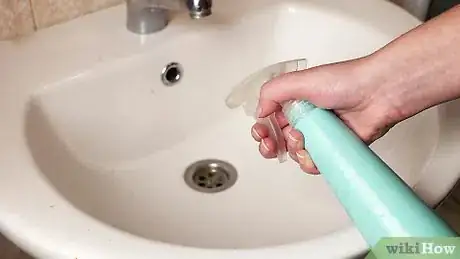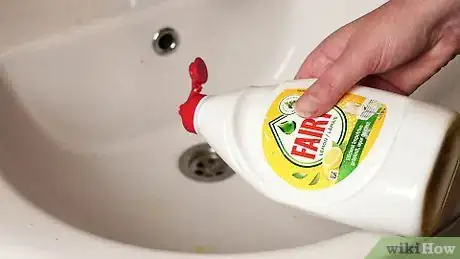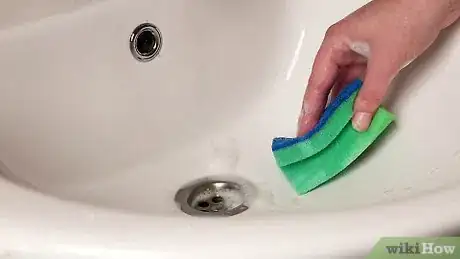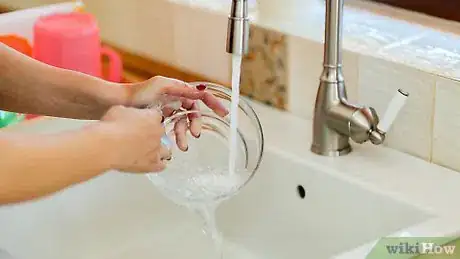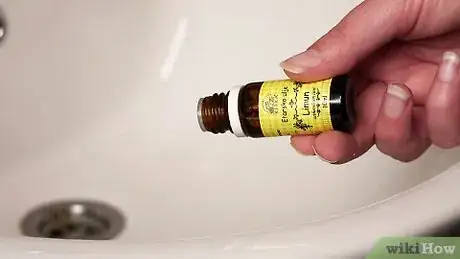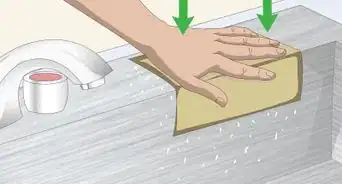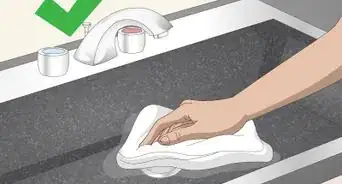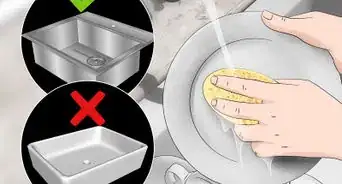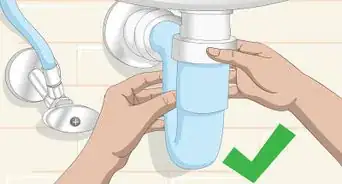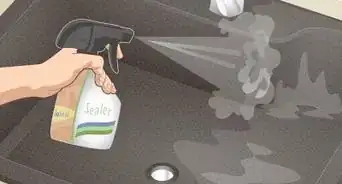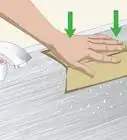This article was co-authored by Michelle Driscoll, MPH. Michelle Driscoll is the Owner of Mulberry Maids, which is based in Fort Collins, Colorado. With five years of experience, her business specializes in cleaning homes and small offices. She holds a Masters in Public Health from the Colorado School of Public Health. Additionally, Mulberry Maids has an A+ rating from the Better Business Bureau.
There are 7 references cited in this article, which can be found at the bottom of the page.
This article has been viewed 82,450 times.
A white sink can complement a kitchen or bathroom perfectly, but the process of keeping one clean can be less than perfect. Simple dish soap may not brighten a well-used one, but anything harsh can scratch the surface and attract dirt. By taking steps to protect your sink and trying easy stain removal techniques, you can keep your white sink looking tip-top.
Steps
Brightening Your Sink
-
1Use white vinegar to remove limescale. Get rid of dull-looking, dingy limescale buildup with white vinegar. Fill an empty spray bottle with pure, white vinegar and spray it on your white sink. Immediately scrub the surface with a non scratch scrub brush or sponge until the buildup is gone. Rinse all the vinegar off with water.[1]
- Vinegar also works as a disinfectant.
-
2Spray your sink with hydrogen peroxide. Hydrogen peroxide will gently brighten up a white sink. Fill a spray bottle with hydrogen peroxide, spray your sink all over and leave it overnight. The hydrogen peroxide will whiten and brighten your sink. Simply rinse and wipe the sink dry the next morning.[2]Advertisement
-
3Wipe your sink down with glass cleaner. Glass cleaner contains ammonia, which will remove dirt and shine a white sink. Spray the surface of your sink with glass cleaner, let it sit for 30 seconds and wipe it dry with a paper towel.
-
4Scrub your sink with baking soda and ammonia. For a monthly deep cleaning of your white sink, mix together a gallon of warm water, a 1⁄4 cup (59 mL) of baking soda and a 1⁄4 cup (59 mL) of ammonia. Soak a non scratch sponge in the mixture and completely scrub your sink’s surface down.
- Rinse well afterwards, so you’re not left with a film from the cleaner.
-
5Spray your sink down with chlorine bleach. Chlorine bleach can eat away at metal drains and faucets, so make sure you avoid these areas when using it to brighten a white sink. Dilute chlorine bleach by adding 1 teaspoon (4.9 mL) to a water filled spray bottle. Spray the surface of your sink, let the mixture sit for a few minutes and scrub with a non scratch sponge. Rinse well with water.[3]
- Never mix chlorine bleach with ammonia, because it forms a noxious gas.
Removing Stubborn Stains
-
1Soak stains with oxygen bleach. Find an oxygenated bleach in powder form and mix it with water according to the manufacturer’s instructions. Dip 2 to 3 rags in the mixture, depending on how large the sink is, and lay the saturated rags along the bottom of the sink. Leave the rags alone for 15 minutes, take them off and scrub any remaining stains with a non abrasive brush.
- Hang saturated rags over the edge of your sink to remove any stains along the sides.
-
2Clean up rust stains with salt and lemon juice. Rust or any other stubborn stains don’t stand a chance to a DIY cleaner made from salt and lemon juice. Sprinkle table salt on any stains, cut a lemon in half to squeeze its juice directly over the salt, and scrub with a clean dish rag. Rinse the area with water and repeat if necessary.
-
3Use liquid dishwasher soap. Liquid dishwasher soap is strong stuff and you only need to leave it on your white sink for a short time to cut through grease, grime and stains. Squirt a small amount onto a soft rag or sponge and wipe your sink down all over with it. Don’t walk away, and rinse your sink with water after one minute.[4]
Preventing a Dirty Sink
-
1Protect the bottom of a kitchen sink with a rubber mat. A rubber mat attached to the bottom with suction cups will protect your sink from dirty dishes and scuffs made by pots and pans. Find an inexpensive mat at your local home store and use it every time you do dishes. Prevent any additional stains and watermarks by removing the mat when it’s not in use.[5]
-
2Wipe and dry your sink out after each use. Get into the habit of wiping your sink after each use to prevent yellowing or staining in the first place. Use a small amount of dish soap on a wet, soft rag or sponge and thoroughly wipe your white sink down. Rinse the soap with water and completely dry the sink with a paper towel or other dry cloth.[6]
-
3Avoid leaving dishes in your sink overnight. Things like coffee, tea or grease can stain white porcelain or fire clay. Make sure you don’t leave half-filled, dripping coffee cups or dirty frying pans in your sink overnight. The longer dirty plates stay in your sink, the longer stains have to set in.
-
4Protect your sink with lemon oil. Polish and give your sink a protective coating with lemon oil. Add several drops of lemon essential oil to a soft, dry cloth to coat your white sink with. Remember to dry your sink out first before adding shine and repelling residue with lemon oil.[7]
Community Q&A
-
QuestionHow do you remove scuff marks?
 Rockysloth_21Community AnswerThere are many ways to clean a sink. You can use a cleaner that is safe for sinks, and also you can get a rag, and with warm water, scrub on any marks. For an even deeper clean, you can use products that are meant for unclogging the drains in sinks. Even using a tissue and rinsing it with water (if you do this often) can prevent bigger marks. It is just an idea, but it works on my sink.
Rockysloth_21Community AnswerThere are many ways to clean a sink. You can use a cleaner that is safe for sinks, and also you can get a rag, and with warm water, scrub on any marks. For an even deeper clean, you can use products that are meant for unclogging the drains in sinks. Even using a tissue and rinsing it with water (if you do this often) can prevent bigger marks. It is just an idea, but it works on my sink.
Warnings
- Be careful when removing stains. Harsh cleaners can etch and dull porcelain.⧼thumbs_response⧽
- Never mix cleaners.⧼thumbs_response⧽
References
- ↑ http://www.abodedesigns.co.uk/support/product-care/ceramic-sinks
- ↑ http://www.bethdreyer.com/blog/2012/03/how-to-clean-a-white-porcelain-sink-without-bleach/
- ↑ http://www.the36thavenue.com/how-to-clean-a-porcelain-sink-2/
- ↑ https://sues-news.com/2010/01/20/removing-stains-from-white-enamel-sink/
- ↑ http://andreadekker.com/our-farmhouse-sink-tips-to-clean-and-care-for-porcelain-sinks/
- ↑ https://www.plumbingsupply.com/how-to-care-for-porcelain-fixtures.html
- ↑ https://www.apartmenttherapy.com/how-to-clean-an-old-porcelain-enamel-bathtub-or-sink-137148
About This Article
To clean a white sink, spray your sink with vinegar and scrub it with a non-scratch scrub brush to remove limescale. Keep your sink clean by wiping it with a mix of equal parts baking soda and ammonia diluted in 1 gallon of water, once a month. Next, add a few drops of lemon oil to a dry cloth and wipe the sink down to add shine and repel residue. To maintain your sink, wipe and dry your sink out after each use, and avoid leaving dishes and food in kitchen sinks overnight, which can lead to stains. For more tips for cleaning sinks, including how to remove rust stains with lemon juice, read on!

